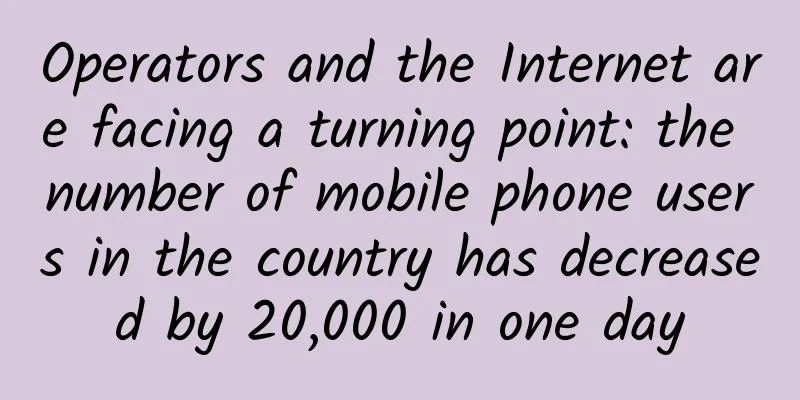After the number portability function is enabled, the largest number of users transfer out of China Mobile

|
Number portability was officially launched nationwide on November 27. Previously, many people speculated that China Mobile would be under the greatest pressure. Judging from the data during the trial operation period released by the Ministry of Industry and Information Technology, China Mobile did indeed have the most lost users among the three major operators.
As of November 26, the number of people who have ported their numbers to other networks accounts for less than 2% of the total number of people. Although the proportion is small, the absolute number is still considerable. Before the official launch, the number portability was piloted in five provinces including Tianjin, Hainan, Jiangxi, Hubei and Yunnan on December 1, 2018. A total of 3.16 million users completed the number portability, accounting for 1.8% of the total number of users. Since the trial operation of number portability in the other 26 provinces on November 10 this year, as of the 26th, a total of 112,000 number portability authorization codes have been issued, assisting 72,000 users to complete the number portability. The number of users who switched out of China Telecom, China Mobile and China Unicom accounted for 16.3%, 57.6% and 26.1% of all users who switched out, respectively, while the number of users who switched in accounted for 49.3%, 28.1% and 22.6%. In other words, China Mobile had the most users who switched out, and when switching to other operators, nearly half of them chose China Telecom. However, when China Mobile released the data, it used another comparison method: the porting rate. China Mobile said that during the trial operation in 26 provinces, their porting rate was only 0.003%, far less than China Telecom's 0.007% and China Unicom's 0.010%. It should be noted that as of August this year, China Mobile's total number of users reached 940 million, 200 million more than China Telecom and China Unicom combined. However, it can also be said that with its existing user base, China Mobile can stay calm. During the trial operation of number portability, the most complained thing was probably the "obstruction" of operators, who refused to allow users to switch networks on the grounds that their contracts had not expired or that they had activated certain services. However, after the official launch, perhaps due to the pressure of public opinion and the restriction of the "Number Portability Service Management Regulations" issued by the Ministry of Industry and Information Technology that "no interference with user choices and obstruction of number portability", the situation seems to have improved. Users who intend to switch networks have received "caring" calls from operators and accidentally unlocked low-priced packages. Obviously, no matter how many users there are, number portability has made the three major operators feel a sense of crisis, which is a good thing for users. Judging from the general feedback on the Internet, price and signal are the two main reasons that prompt users to change operators. China Unicom and China Telecom have captured a lot of users with their Internet packages in recent years. In this regard, China Mobile's response is quite slow, but the signal problems of China Unicom and China Telecom are also often criticized. It seems difficult to have the best of both worlds. In addition to the restrictions on porting out, technical issues such as the inability to recharge the mobile phone normally and the inability to receive text messages after number portability have also made many people hesitant. According to the Ministry of Industry and Information Technology, for the problem of not receiving text messages, the three operators have adopted a "bottom-line forwarding" approach, using the inter-network forwarding function to solve the problem of text messages sent to the wrong telecom company after number portability. With the arrival of 5G, the coverage and experience of 5G signals will play a decisive role when the package prices of the three companies are almost the same. Perhaps the peak of number portability will come after 5G becomes popular in the next few years. |
<<: Animation: How does a browser work?
Recommend
P2P market needs regular troops. Yunyou Holdings acquires Jianlicai to focus on technology finance
[51CTO.com original article] The earliest P2P onl...
ProfitServer: 50% off VPS in Hong Kong/Singapore/Russia/Spain/Netherlands/Germany, starting from $2.88 per month for unlimited traffic
ProfitServer recently offered a 50% discount on s...
How many IP addresses are there in China?
The topic we are going to talk about today is abo...
Operators remove many 4G packages to make way for 5G, user experience may be affected
Recently, China Mobile's online business hall...
Current Affairs | How many cards does the US have left to crush China’s 5G?
In the battle for 5G, China has gained a first-mo...
If we can't be fashionable, we should be stable. Which of the big guys in the technology circle looks most like an old cadre?
The bigwigs in the tech industry all have their o...
Protocol-Oriented Programming and Cocoa (Part 2)
[[403619]] This article is a summary of the autho...
RAKsmart: Hot-selling servers start at $46/month, bare metal cloud starts at $69/month, cluster servers start at $160/month
RAKsmart has launched a new month of promotions, ...
80VPS: Japan/Hong Kong VPS annual payment starts from 299 yuan, Los Angeles VPS annual payment starts from 199 yuan
80VPS, a well-established Chinese hosting company...
A Preliminary Study on Software Defined Network (SDN)
【51CTO.com Quick Translation】Before 2008, the ent...
What are honeypots, honey baits, honey tags, honeynets, honey farms... in network security?
As security practitioners, whether we are doing p...
What can 5G messaging bring to industry customers?
5G messaging is planned and built based on the GS...
Facing these possible accidents, is your operation and maintenance team ready?
With a loud bang, the data center collapsed The d...
Symantec releases new CISO survey: Cloud becomes the next starting point for cybercrime
Recently, Symantec, a global leader in cybersecur...
Let's not talk about the principle, let's talk about the ready-to-use thread pool
This article is reproduced from the WeChat public...









